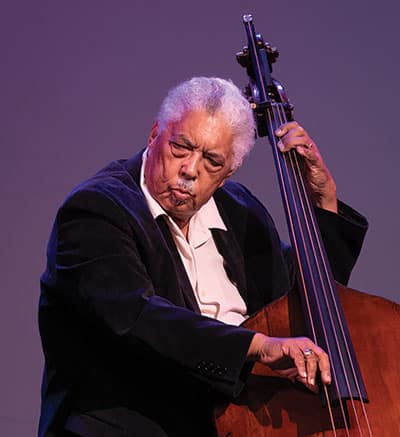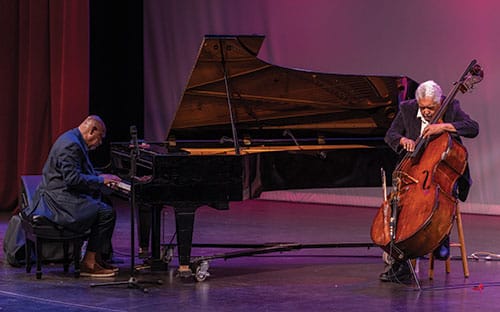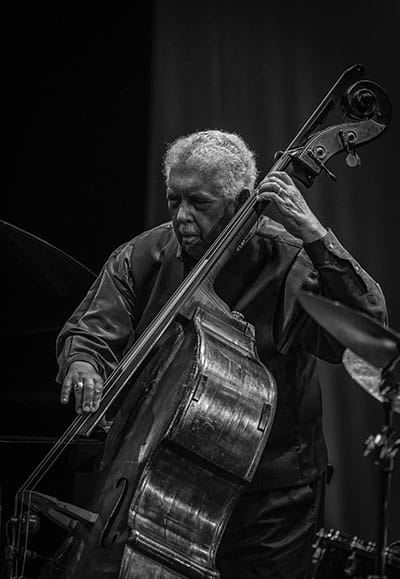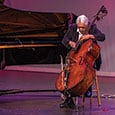Editor’s Note: This article originally appeared in our well-loved but short-lived publication for younger musicians called Accent in January/February 1978.
 At the time of this interview, Rufus Reid, jazz bass artist and author, had recently joined the Thad Jones-Mel Lewis Orchestra. His background in both classical and jazz music made him one of the most sought-after rhythm section players.
At the time of this interview, Rufus Reid, jazz bass artist and author, had recently joined the Thad Jones-Mel Lewis Orchestra. His background in both classical and jazz music made him one of the most sought-after rhythm section players.
Reid began his musical training on trumpet, which he studied from elementary through high school in Sacramento, California. He then entered the military as a trumpet player in an Air Force band. During the time he was stationed in Japan, he began to teach himself to play the bass. When he returned to the States, he studied with James Harnett, principal bassist of the Seattle Symphony. He continued his studies at Northwestern University where he studied with Warren Benfield. of the Chicago Symphony Orchestra. While in Chicago, he gained extensive jazz experience playing at the Jazz Showcase with artists such as Dizzy Gillespie, Art Farmer, and McCoy Tyner. His first book, The Evolving Bassist, became the preeminent work on jazz bass playing. In 1979, Reid joined William Paterson University as director of jazz studies, helping to develop the University’s bachelor of music program in jazz studies and performance. This program was the first professional academically accredited bachelor of music in jazz in the area. After leading the program for two decades, he retired in 1999 to continue his performance and composition career. At age 79, Rufus Reid continues to teach and perform.
* * *
One of the things that has made Rufus Reid in demand as a rhythm section player is that he can swing. His powerful rhythmic drive gives any band a kick to propel it forward.
Reid knows that the strength of a band depends heavily on its often-overlooked rhythm section. “If the rhythm section is weak, the band won’t make it – even if it has a fantastic horn section,” he says. “When the rhythm section lacks energy, good lead players aren’t able to play as well as they might. If the rhythm section is really strong, the band can sound great, even with mediocre lead players.”
The main job of the rhythm section is to be an energy force to push the hand ahead. The players have to learn how to pace themselves since the rhythm section must play continuously without letting up on the energy level. When Reid works with high school musicians in clinics, he tells them to get out and play so hard that they work up a sweat. “I tell them that I don’t want them to be able to wear the same shirt the next night. It cracks up the players, but it does tell them something about their energy level.”
In the best rhythm sections, each member is playing well enough to keep a strong pulse, and the players are all listening closely to everything that’s going on around them. Reid says that school jazz bands tend to sound stiff and academic, even though the players may be technically very strong. “Any rhythm section member – on bass, piano, drums, guitar, trombones, whatever – should be able to make you tap your foot with whatever he is playing. He should generate enough pulse that he could drive the band on his own. The player also has to be able to lock into a time continuum as a unit with the other players. Then when they’re all really listening to each other, they begin to take off.”
Reid says that the thing that’s probably overlooked the most in rhythm sections is that each player has to be able to stand on their own. Very often if the drummer and keyboard player are strong, for example, a weak bass player will start leaning on them. “I learned the importance of being able to stand on my own from a drummer named Wilbur Campbell. When I first started playing with him, he kept doing things I couldn’t quite figure out. It would sound as if he was taking the rhythm in one direction, and so I’d try to follow him. When the time came to go somewhere else, he went that way while I kept going. It was like falling over the edge of a cliff, and he just left me hanging there. It was my own fault because I’d been leaning on him and hadn’t really kept the pulse myself. Once I learned what he was doing, I became a much stronger player and began to stand on my own two feet.”
So the first step in building a rhythm section is for each player to be independently strong, capable of staying on the beat without getting distracted by another player’s improvisations. Then, when the players are together and start listening to each other closely, the rhythm section can be much more powerful. Reid also recommends that the rest of the band should try practicing without the rhythm section to develop rhythmic independence, too.

Pianist Kenny Barron and Bassist Rufus Reid
Every rhythm section member is first and foremost a timekeeper for the group and must fulfill some basic responsibilities. Rhythm players should only improvise if they can do so while still fulfilling the major job of keeping the pulse. Here are the specific things Reid says are expected of the drummer, bassist, and pianist:
Drummer’s Role
• Provide these basic elements: (1) hi-hat on 2nd and 4th beat; (2) broken triplet pattern with cymbal; and (3) emphasis from the bass drum, usually on the 1st and 3rd beats (Reid adds that Mel Lewis uses the bass drum to gently accentuate all four beats for a heartbeat effect).
• Be sensitive; overcome the tendency of drummers to drown out everyone. When the drummer plays too loudly, the whole band will overplay.
• Be flexible and listen to what others are doing rhythmically; don’t try to shove your beat down everyone else’s throats.
• Maintain the same high energy level when you play slowly or softly as you do when playing loudly and fast.
• Be able to play very softly. It can be very hard to do this, especially if you’ve been working with practice pads, but it’s essential.
Bassist’s Role
 • Provide these two basic elements: (1) play in steady time through chord changes to create an energetic walking feeling; and (2) supply harmonic background: chords, arpeggios, and scales.
• Provide these two basic elements: (1) play in steady time through chord changes to create an energetic walking feeling; and (2) supply harmonic background: chords, arpeggios, and scales.
• Remember that rhythmic embellishments and solo lines are frosting on the cake; they definitely help bring the music to life, but you shouldn’t sacrifice playing the right notes in good time for sloppy out-of-tune notes played with poor rhythm.
Pianist’s Role
• Generally use chord blocks in both hands, unless accompanying in rubato style.
• Don’t overplay; when you’re not soloing, remember that you’re accompanying, so don’t crowd the soloist with your busy lines.
• Vary your chord voicings; learn different inversions of chords.
• Consider your register; play in a different register than the soloist; for example, if the soloist is playing a high trumpet part, stay in the low register.
• You and the guitar should be aware of each other at all times; try to play in separate ranges and also to comp sparsely so you each play when the other isn’t.
Other Members’ Roles
• Keep a strong pulse.
• Don’t overplay; if the texture is getting too thick, take a rest and let in some daylight.
Strengthening Your Rhythm
You need to work alone and also with the other members of a rhythm section. Reid says that you will probably have to coach yourselves, since school jazz band directors tend not to pay much attention to the rhythm section, especially if they’ve got a decent brass section.
The first step is to start listening intently to the style of music you want to play. “I used to listen to a record over and over until I’d actually wear it out,” Reid says. “I kept hearing different things all the time. I’d hone in, just hear the bass, then the other instruments. After a while, I got to the point where I could hear the bass and also the drums, hearing how the bassist reacted to what the drummer did. Some stereo records have the bass and drums on separate channels, so you can tune into just the bass or drums in one speaker. You can also get good practice by playing along with the records that interest you or with the special improvisation records that have your instrument part left out for you to fill.”
He recalls one high school clinic with the Thad Jones/Mel Lewis band where the school’s jazz band performed one of Thad Jones’ arrangements. “It was a very difficult arrangement, as a lot of Thad’s things are. The students had only heard the record once, and they probably weren’t looking at the music when they heard it. These students were destroying the music; they could read it, but there was no concept of what the music was all about. One of the advantages to playing Thad’s music is that practically all of his charts are on record. So. that’s part of doing your homework, sitting down and actually looking at the music and listening to what’s being done with it. If you listen over and over to the dynamics and the inflections, it’s easy to get an idea of how the music should go.”
The best listening exercise is to follow a score or a part to a jazz chart while listening to a recording. “Listen to the inflections and then try to mimic then exactly,” he advises. “Make markings in the score to show any dynamics and nuances – swelling, staccato, legato, etc. – that aren’t present in the published score. Listen especially for the degree of change: if a note is accented, listen to how much it is accented.
“You have to strive as hard as possible to get the same kind of sound that you hear from great artists. You can only learn to swing by listening to enough good music that does swing; eventually you’ll soak it up.” He describes “swing” as “a certain rhythmic pocket where everyone is just clicking right along together as if it could never be any other way.”
Swing requires an aggressive energy and a certain snap to push things along, he explains. To demonstrate, he picked up a pencil and tapped out even quarter notes on the edge of a table, keeping his wrist rigid. The beat was very flat and full. “The drummer who chokes like this, holding the stick too tight, will also tighten the beat. It takes real wrist action to snap the cymbal.” He demonstrated with his makeshift drumstick, keeping his wrist loose and adding a snap that suddenly gave impetus to the beat.
The same principle applies to the bass and piano. The bassist needs to use plenty of arm weight to pull on the string with a snap. The pianist should use a sharp attack rather than a mushy one. “The more energy you put in,” he says, “the more you’ll produce.”
Probably the single greatest barrier to swing is when players get so preoccupied with what notes to play that they stop thinking about the pulse. Young players are often so anxious to show off their dazzling technique that they forget about keeping the beat. By listening to how various great players put real impetus and drive behind even the simplest rhythm patterns, you can see that the timekeeping job doesn’t have to be monotonous.
“I can’t overemphasize the importance of listening to a lot of records and then copying what you hear. School players tend to be great readers but they just don’t listen enough so their ear isn’t developed. If you don’t listen to records, you’ll keep coming up with something you think is new even though it was done before you were born.”
Check a local library or record store for vintage recordings so you can hear jazz of all eras. Then you can soak up sort of a history of jazz and also develop a repertoire of jazz styles, which is essential for free-lancers. “If you’re hired as a bassist for a job and you’re told to play something in the style of Stanley Clarke, you’ve got to know that it would have a freer feeling than earlier jazz bass styles and that that bass line might have something of a samba feeling. A pianist who is told to play something like George Shearing had better know that Shearing was known for playing block chords, moving around with the entire hand.”
Troubleshooting
If your band ever starts to fall apart rhythmically during a performance, you should have several emergency plans ready. “Talk about what to do in that situation.” Reid says. “Everyone should agree on whether they’re going to yield to the soloist, or follow the drummer (it’s easy to hear the hi-hats on the 2nd and 4th beats), or listen to the piano player. Don’t be afraid to look around at each other and maybe have one player cue the others somehow by raising a hand, shaking the head, or whatever. Just make sure that everyone knows whom to follow.”
Some common problems are that at medium-slow tempos, everyone tends to drag, while at faster tempos the band may not be relaxed enough, and when a drummer tenses up, the tempo starts rushing. Bass players generally tend to drag tempos from lack of control and from tightening up; Reid suggests that they work on breathing evenly to stay relaxed and to keep phrases even as they play.
The metronome can help develop steadier tempos. “I sometimes practice with a metronome,” he says. “You can swing with it, too. It can help you dissect a rhythmically difficult chart, so you can figure out exactly where the main beats lie. You can have some fun trying to play with a friend while staying with a metronome; the results can be pretty funny.”
As the rhythm section works together, balance is sometimes a major problem. Either the bass and piano are drowned out by the rest of the section, or if they’re amplified, the entire band plays too loudly. Reid recommends that the bass player use a foot pedal for volume control with either an electric bass or amplified acoustic bass.
The rhythm section can control the volume of the whole band. “If the band is playing loudly and then suddenly the rhythm section cuts the volume to a softer level with the same amount of energy, the rest of the band, if they’re listening to the rhythm section, will all play a little more softly too.” He says that in Thad Jones/Mel Lewis’ band he enjoys the way the band can really swing when it plays softly. He also cites Count Basie’s band as a phenomenal band that can really swing and stay very crisp at a soft level. Basie’s band also has mastered keeping the whole section together at a very slow tempo, too, which demands so much concentration that many players become unglued.
It’s clear that Reid is proud to be a part of the Thad Jones band, especially for the way the players all listen to each other intently in the concerts instead of just being absorbed in their own playing. “It’s great. The band members will come up to each other after the concert and say, ‘I really liked what you did during that solo’ or ‘You were really nice on that tune.’ It’s very refreshing, and I find that it’s made me really happy in the band. It sounds corny, but since I joined the band I’ve suddenly found myself walking down the street humming and whistling.”
To maintain a high energy level in playing means that you have to fight extra hard to combat the natural human tendency towards laziness, Reid says. He learned a lesson in the value of practice through an unusual incident involving the great swing bassist Ray Brown. When Reid was first taking up the bass while stationed in Japan in the Air Force, he met Brown, who was on tour with pianist Oscar Peterson. “I got a chance to hang out with him for a couple of weeks and made a nuisance of myself I’m sure. He’s such a phenomenal musician and a grand person that I was really in awe of him. Everything about him was so positive.”
One encounter with Brown was a turning point for Reid. “Up until then, I’d practiced in spurts, but never developed a real routine. Things come easy to me I guess, so as soon as I’d pick something up, I wouldn’t worry about it any more, and when I’d go to reach for it, it might not be there securely. At the time I met Ray Brown, he seemed to me like the only bass player in the world, and he could do no wrong.
“One night after a late concert he had invited me to come see him the next day. So the next morning I went to his hotel at about 10:00 and was surprised that through the door I could hear him playing. After I knocked, he came to the door in his underwear. He hadn’t even gotten dressed yet and here he was practicing scales, with the bow and everything. That floored me. Here was the greatest player in the world; why should he practice anymore? I began to understand: that’s why he’s the greatest. He had made it a routine that he must touch the instrument at least a certain amount of time each day. That incident did a number on me, it really did.”
Since then Reid has established a set practice routine. “Now even when I can’t practice the instrument physically, I’m practicing mentally. That is, when I’m working on a song, I’ll try to hear it or visualize it in my head. So when I actually pick up the instrument, it’s not cold turkey right away. The first time I got a chance to play with the Thad Jones/Mel Lewis band, I didn’t have a chance to rehearse with them. I had a three-hour bus ride to the job, so I went over the tunes mentally. I wouldn’t haven’t been invited to join the band without that practice.
Photos by Kishore Seshadri





